The Timeless Charms of Stone Fireplaces
Stone fireplaces have been a focal point in homes for centuries, revered for their durability, natural beauty, and timeless appeal. These fireplaces bring a touch of nature indoors, creating a rustic yet elegant atmosphere that can enhance any room. The use of stone in fireplace design offers endless possibilities, from classic and traditional to modern and contemporary styles.
The appeal of stone fireplaces lies in their ability to blend seamlessly with various architectural styles. Whether in a cozy cottage, a grand manor, or a modern urban loft, stone fireplaces can be designed to complement and enhance the surrounding decor. The natural variations in stone color, texture, and pattern add unique character to each fireplace, making every installation one-of-a-kind.
Beyond aesthetics, stone fireplaces are also valued for their functionality. Stone is an excellent conductor of heat, which means that these fireplaces not only create a beautiful focal point but also provide efficient and effective heating. This makes them a practical choice for homeowners who want to combine beauty with functionality in their living spaces.

Another significant advantage of stone fireplaces is their durability. Unlike other materials that may wear out or require frequent maintenance, stone is incredibly resilient and can withstand the test of time. This longevity ensures that a stone fireplace remains a centerpiece in the home for generations, retaining its beauty and functionality.
The process of designing and constructing a stone fireplace can be highly customizable. Homeowners can choose from a variety of stone types, including granite, limestone, slate, and river rock, each offering distinct aesthetic and functional properties. The choice of stone, combined with the design of the fireplace itself, allows for a highly personalized installation that reflects the homeowner’s style and preferences.
The timeless appeal of stone fireplaces lies in their unique blend of beauty, functionality, and durability. These fireplaces can be tailored to suit any home and provide a stunning centerpiece that adds warmth and character to the living space. The natural elegance of stone, coupled with its practical benefits, makes stone fireplaces a sought-after feature in both traditional and modern homes.
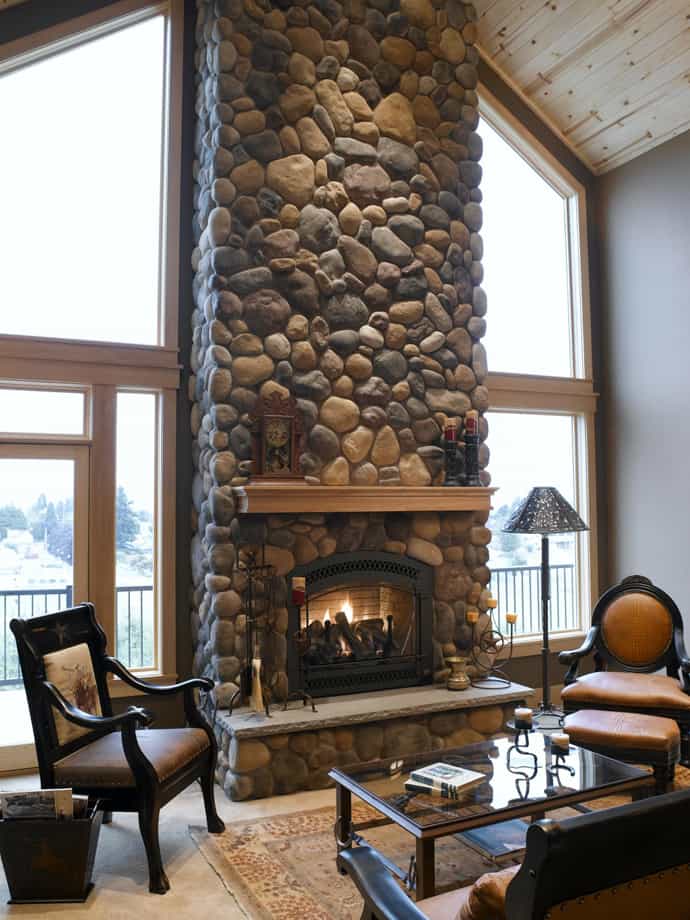
Exploring Different Stone Types
Granite Fireplaces
Granite is a popular choice for stone fireplaces due to its durability, strength, and elegant appearance. This igneous rock is formed from cooled magma and is known for its hardness and resistance to heat, making it an ideal material for fireplace construction. Granite fireplaces can range from polished, sleek surfaces to more rustic, rough-hewn designs, offering versatility in design options.
One of the key benefits of granite is its wide range of colors and patterns. Granite comes in various shades, including black, gray, pink, and white, often with intricate veining or speckling. This variety allows homeowners to select a granite that complements their interior decor and personal style. Whether you prefer a dramatic black granite fireplace or a subtler, lighter hue, there is a granite option to suit every taste.
Granite’s durability is another major advantage. This stone is incredibly resistant to scratches, stains, and heat, making it a practical choice for fireplaces that see regular use. The robust nature of granite ensures that the fireplace will maintain its beauty and structural integrity over time, even in the face of high temperatures and frequent use.
Maintenance of granite fireplaces is relatively straightforward. Regular cleaning with a mild detergent and water is usually sufficient to keep the surface looking pristine. For polished granite, occasional resealing may be necessary to maintain its shine and prevent staining. This minimal maintenance requirement makes granite a convenient option for busy homeowners.
In terms of design, granite can be used in various ways to create different aesthetic effects. A polished granite fireplace can provide a sleek, modern look, while a rough-cut granite fireplace can evoke a more rustic, traditional feel. Granite can also be combined with other materials, such as wood or metal, to create unique and striking designs.
Granite fireplaces offer a blend of beauty, durability, and versatility. The wide range of colors and patterns, combined with granite’s robust nature, make it an excellent choice for homeowners looking to add a stunning and long-lasting feature to their living space. Whether used in a traditional or contemporary design, a granite fireplace is sure to enhance the aesthetic and functional value of any home.

Limestone Fireplaces
Limestone is another popular choice for fireplace construction, known for its soft, neutral tones and smooth texture. This sedimentary rock is composed primarily of calcite and often contains fossilized remains of marine organisms, adding unique character and history to each piece. Limestone fireplaces bring a natural, understated elegance to any room, making them a favored choice among homeowners and designers.
One of the primary advantages of limestone is its versatility in design. Limestone can be carved and shaped into intricate designs, allowing for detailed mantels, surrounds, and hearths. This adaptability makes limestone suitable for both classic, ornate fireplaces and sleek, modern designs. The stone’s natural beauty and subtle variations in color and texture add a refined, sophisticated touch to any fireplace.
Limestone’s light, neutral colors, ranging from creamy whites and soft beiges to warm tans and grays, make it easy to integrate into various interior design schemes. These muted tones create a calm and inviting atmosphere, enhancing the overall aesthetic of the living space. Limestone fireplaces can act as a focal point without overwhelming the room, blending seamlessly with other design elements.
While limestone is softer and more porous than granite, it is still a durable and long-lasting material. Proper care and maintenance can help preserve its beauty and functionality. It is important to seal limestone surfaces to protect them from stains and moisture. Regular cleaning with a pH-neutral cleaner will help maintain the stone’s appearance and prevent damage.
The natural texture and finish of limestone can also be customized to suit different design preferences. A honed finish, which is smooth but not glossy, is popular for its elegant and understated look. For a more rustic or antique appearance, a tumbled or antiqued finish can be used. These finishes enhance the stone’s natural beauty and add character to the fireplace.
Limestone fireplaces offer a unique combination of natural beauty, versatility, and elegance. The stone’s soft, neutral tones and ability to be shaped into intricate designs make it an ideal choice for creating sophisticated and inviting fireplace designs. With proper care and maintenance, a limestone fireplace can be a stunning and enduring feature in any home.

You May Want to Check These Articles:
- Stone Fireplace Floor To Ceiling
- Stone Fireplace Before And After
- Stone Fireplace Vaulted Ceiling
- Stone Fireplace Designs Pictures
- Stone Fireplace Materials
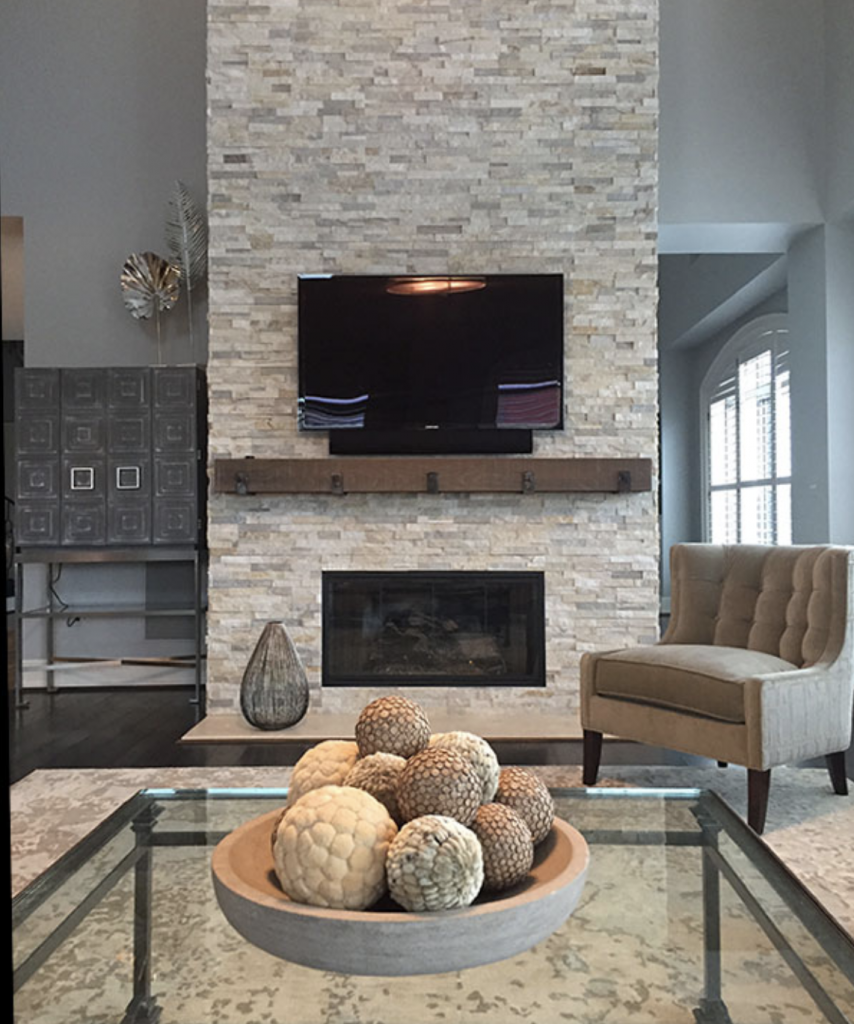
Slate Fireplaces
Slate is a metamorphic rock that is highly prized for its distinctive texture, durability, and range of colors. It is formed from clay and volcanic ash, compressed over millions of years, resulting in a material that is both strong and visually striking. Slate fireplaces offer a unique aesthetic that can enhance both traditional and contemporary interiors.
One of the most appealing aspects of slate is its natural cleft surface, which provides a textured, rustic look. This texture adds depth and interest to the fireplace, making it a focal point in the room. Slate is available in a variety of colors, including shades of gray, green, black, red, and purple, often with beautiful variations and patterns within a single piece.
The durability of slate makes it an excellent choice for fireplaces. It is resistant to heat, scratches, and stains, ensuring that the fireplace will remain in good condition even with regular use. This robustness, combined with its unique aesthetic qualities, makes slate a popular choice for both residential and commercial applications.
Maintenance of slate fireplaces is relatively simple. Regular cleaning with a soft brush or cloth and mild soap and water will keep the surface looking its best. For enhanced protection, especially in high-traffic areas or where the stone is exposed to moisture, sealing the slate can help prevent stains and maintain its natural beauty.
Slate’s versatility extends to its design applications. It can be used in various forms, such as tiles, slabs, or stacked stone, to create different looks. A slate tile fireplace can provide a clean, contemporary feel, while a stacked slate can evoke a more rustic, natural appearance. The stone can also be combined with other materials, like wood or metal, to create unique and customized designs.
Slate fireplaces offer a distinctive and durable option for those looking to add a unique touch to their living spaces. The natural texture, wide range of colors, and versatility in design make slate a compelling choice for fireplace construction. Its combination of beauty and practicality ensures that a slate fireplace will be a stunning and functional feature in any home.

River Rock Fireplaces
River rock fireplaces bring a touch of the outdoors inside, creating a natural and rustic ambiance that is both charming and inviting. These fireplaces are constructed using smooth, rounded stones that have been naturally shaped by water over time, resulting in a unique and organic look. River rock fireplaces are particularly popular in cabins, lodges, and homes with rustic or country-style decor.
One of the main attractions of river rock is its natural beauty. The stones come in a variety of shapes, sizes, and colors, ranging from grays and browns to blues and greens. This diversity allows for creative and personalized designs, with each fireplace having its distinct character. The irregular shapes and textures of river rock add depth and interest, making the fireplace a focal point in any room.
The construction of a river rock fireplace requires careful planning and skilled craftsmanship. Each stone must be selected and placed to create a balanced and aesthetically pleasing design. The stones are typically set in mortar, with attention to the gaps and joints to ensure a sturdy and durable structure. The result is a fireplace that looks as if it has been naturally formed over time, adding authenticity and charm to the space.
River rock fireplaces are not only beautiful but also functional. The stones’ natural density and heat retention properties make them effective at radiating warmth, creating a cozy and comfortable environment. This makes river rock fireplaces an excellent choice for homes in colder climates or those looking to create a warm and inviting gathering space.
Maintenance of river rock fireplaces involves regular cleaning to remove dust and soot. The stones can be cleaned with a soft brush or vacuum to maintain their natural appearance. It is also important to inspect the mortar joints periodically and repair any cracks or damage to ensure the fireplace remains structurally sound.
River rock fireplaces offer a unique and natural aesthetic that brings the beauty of the outdoors into the home. The diverse colors, shapes, and textures of the stones create a one-of-a-kind look that can enhance any rustic or country-style decor. With proper construction and maintenance, a river rock fireplace can be a stunning and functional centerpiece that adds warmth and character to any living space.
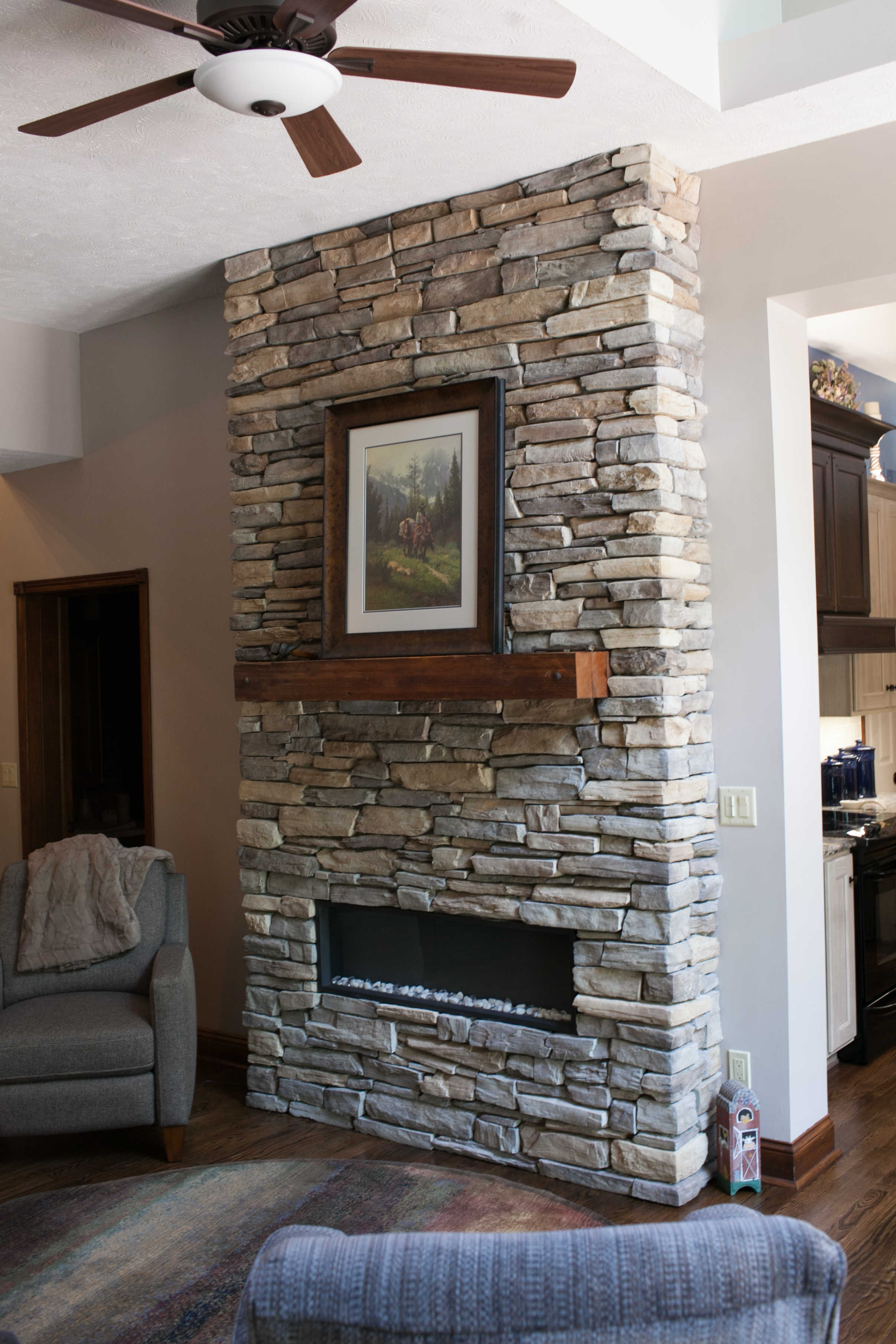
Marble Fireplaces
Marble fireplaces are synonymous with luxury and elegance, offering a sophisticated and timeless appeal that can elevate any interior space. Marble is a metamorphic rock formed from limestone subjected to high pressure and heat, resulting in a material that is both durable and stunningly beautiful. The use of marble in fireplace design dates back to ancient times, reflecting its enduring popularity and status.
One of the most striking features of marble is its natural veining and color variations. Each piece of marble is unique, with intricate patterns and shades ranging from pure white and cream to deep black, green, and red. This variety allows homeowners to select a marble that complements their decor and personal style, creating a fireplace that is both a functional feature and a work of art.
Marble’s smooth, polished surface adds a touch of refinement and sophistication to any room. Whether used in a classic, ornate design or a sleek, modern installation, marble fireplaces exude a sense of grandeur and elegance. The reflective quality of polished marble also enhances the sense of space and light, making the room feel more open and inviting.
In addition to its aesthetic appeal, marble is also valued for its durability and heat resistance. Marble fireplaces can withstand high temperatures without damage, making them a practical choice for homes that use their fireplaces frequently. However, marble is softer and more porous than other stones like granite, so it requires careful maintenance to prevent staining and scratching.
Proper care of a marble fireplace involves regular cleaning with a soft cloth and a pH-neutral cleaner to avoid damaging the surface. It is also advisable to seal the marble periodically to protect it from moisture and stains. Avoid using abrasive cleaners or tools that can scratch the surface, and promptly clean up any spills to prevent staining.
In terms of design, marble can be used in various ways to create different effects. A full marble surround can provide a dramatic and luxurious look, while a marble mantel or hearth can add subtle elegance. Marble can also be combined with other materials, such as wood or metal, to create a unique and personalized design.
Marble fireplaces offer a blend of luxury, elegance, and durability. The natural beauty of marble, with its unique veining and color variations, creates a stunning focal point that can enhance any interior space. With proper care and maintenance, a marble fireplace can remain a beautiful and functional centerpiece for many years.

Stacked Stone Fireplaces
Stacked stone fireplaces bring a rugged, natural look to any room, offering a sense of rustic charm and outdoor beauty. These fireplaces are constructed using thin, flat pieces of stone stacked together, often without visible mortar, to create a textured, layered effect. Stacked stone fireplaces are versatile and can be used in both traditional and contemporary settings, adding depth and visual interest to the space.
One of the main attractions of stacked stone fireplaces is their natural, organic appearance. The stones come in a variety of colors, shapes, and sizes, allowing for a wide range of design possibilities. The irregular, rough-hewn edges of the stones create a rustic, handcrafted look that can make any room feel warm and inviting.
The construction of a stacked stone fireplace requires careful selection and placement of the stones to achieve the desired look. Skilled craftsmanship is essential to ensure that the stones are securely stacked and the overall structure is stable. The result is a fireplace that looks as if it has been naturally formed over time, adding authenticity and character to the room.
Stacked stone fireplaces are not only aesthetically pleasing but also highly functional. The stones’ natural heat retention properties make them effective at radiating warmth, creating a cozy and comfortable environment. This makes stacked stone fireplaces an excellent choice for homes in colder climates or those looking to create a warm and inviting gathering space.
Maintenance of stacked stone fireplaces involves regular cleaning to remove dust and soot. The stones can be cleaned with a soft brush or vacuum to maintain their natural appearance. It is also important to inspect the mortar joints periodically and repair any cracks or damage to ensure the fireplace remains structurally sound.
Stacked stone fireplaces offer a unique and natural aesthetic that brings the beauty of the outdoors into the home. The diverse colors, shapes, and textures of the stones create a one-of-a-kind look that can enhance any rustic or contemporary decor. With proper construction and maintenance, a stacked stone fireplace can be a stunning and functional centerpiece that adds warmth and character to any living space.
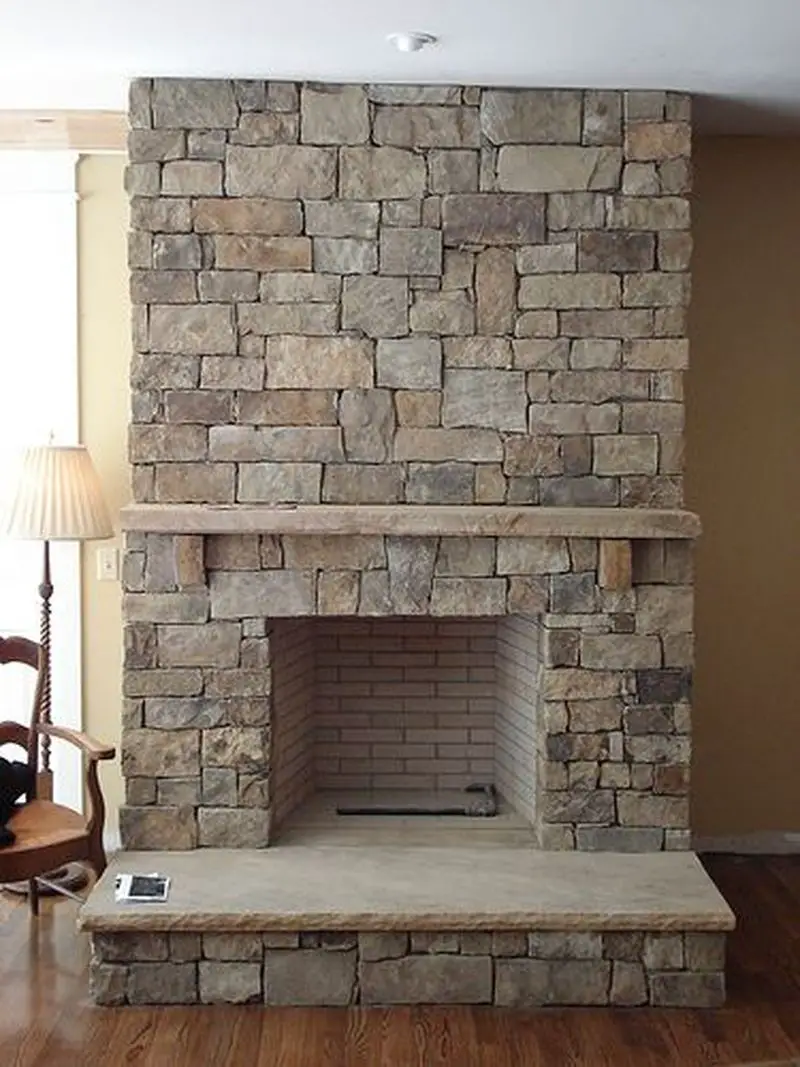
Customizing Your Stone Fireplace
Incorporating Mantels and Hearths
Adding a mantel and hearth to your stone fireplace can enhance its functionality and aesthetic appeal. These elements provide additional opportunities for personalization and can help to create a cohesive look that complements the overall design of your home.
A mantel serves as a shelf above the fireplace, offering a place to display decorative items, family photos, or seasonal decorations. The design of the mantel can significantly impact the look of the fireplace. For a rustic or traditional style, a wooden beam mantel can add warmth and character. For a more modern look, a sleek, stone or metal mantel can provide a clean, contemporary finish.
The hearth is the floor area in front of the fireplace, often made of the same or complementary material as the fireplace itself. A raised hearth can provide additional seating or a place to store firewood, while a flush hearth offers a streamlined look that blends seamlessly with the floor. The choice of material and design for the hearth can enhance the overall aesthetic of the fireplace.
When customizing your fireplace with a mantel and hearth, consider the proportions and scale of the elements. A large, imposing fireplace may require a substantial mantel and hearth to balance its size, while a smaller fireplace can benefit from more delicate, understated elements. The materials and colors should also complement the stone used in the fireplace to create a harmonious look.
The functionality of the mantel and hearth should not be overlooked. The mantel should be at a comfortable height for displaying items, and the hearth should be durable enough to withstand the heat and weight of logs. Consider the practical aspects of these elements, such as the ease of cleaning and maintenance, to ensure they remain beautiful and functional over time.
Incorporating a mantel and hearth into your stone fireplace design can enhance both its aesthetic and functional qualities. These elements provide additional opportunities for personalization and can help to create a cohesive and inviting look that complements the overall design of your home. By carefully selecting the materials, proportions, and design details, you can create a customized fireplace that reflects your style and enhances your living space.

Choosing the Right Stone Veneer
Stone veneer is a popular option for those looking to achieve the look of a stone fireplace without the weight and expense of full-sized stones. Veneer is made from thin slices of natural or manufactured stone, providing the same aesthetic appeal as traditional stone at a fraction of the cost. Choosing the right stone veneer involves considering factors such as style, color, and texture to ensure a cohesive and attractive design.
One of the main advantages of stone veneer is its versatility. The veneer can be applied to a variety of surfaces, including brick, concrete, and drywall, making it a flexible option for different types of installations. This versatility allows homeowners to achieve the look of a stone fireplace in spaces where full-sized stone would be impractical or too heavy.
The variety of stone veneers available means that there is an option to suit every style and taste. Natural stone veneer is made from real stone, offering the same variations in color and texture as full-sized stone. Manufactured stone veneer, on the other hand, is made from lightweight materials and can be molded to replicate the look of various types of stone. Both options provide a realistic and attractive finish, but natural stone veneer tends to offer a more authentic appearance.
When choosing stone veneer, consider the color and texture that will best complement your existing decor. The color of the veneer should harmonize with the room’s color scheme, while the texture should enhance the overall aesthetic. For example, a rough-textured veneer can add a rustic charm to a traditional room, while a smooth, uniform veneer can create a sleek, modern look.
Installation of stone veneer requires careful preparation and skilled craftsmanship. The surface must be properly prepared to ensure that the veneer adheres securely. This often involves cleaning, priming, and applying a scratch coat to the substrate. The veneer pieces are then arranged and fixed in place, with attention to the joints and edges to achieve a natural, seamless look.
Stone veneer offers a cost-effective and versatile way to achieve the look of a stone fireplace. The variety of options available in terms of style, color, and texture allows homeowners to customize their fireplaces to suit their tastes and the overall design of their homes. With proper installation and careful selection, stone veneers can provide a stunning and durable finish that enhances the beauty and functionality of any fireplace.

Integrating Lighting
Integrating lighting into your stone fireplace design can enhance its visual impact and create a warm, inviting atmosphere. Proper lighting can highlight the texture and color of the stone, making the fireplace a focal point in the room. There are several types of lighting options to consider, each offering different effects and benefits.
Accent lighting is one of the most effective ways to highlight a stone fireplace. Recessed lights or spotlights can be installed in the ceiling or walls to direct light onto the fireplace, emphasizing its features and creating dramatic shadows. This type of lighting can enhance the natural texture and color variations of the stone, making it stand out in the room.
Ambient lighting can create a cozy and inviting atmosphere around the fireplace. This can be achieved with wall sconces, floor lamps, or table lamps placed strategically around the room. The soft, diffused light from these fixtures can complement the warmth of the fireplace, making the space feel more comfortable and welcoming.
Under-mantel lighting is another option to consider. LED strip lights can be installed under the mantel to provide a subtle, glowing effect that highlights the fireplace without overpowering the room. This type of lighting can add a modern touch to the design and enhance the overall ambiance.
For a more dramatic effect, consider integrating colored lighting into your stone fireplace design. LED lights with color-changing capabilities can be used to create different moods and atmospheres. This can be particularly effective for creating a festive or themed look for special occasions and holidays.
When integrating lighting into your fireplace design, it is important to consider the placement and intensity of the lights. The goal is to enhance the fireplace’s features without creating harsh shadows or glare. Dimmers can be used to adjust the light levels and create the desired ambiance. Additionally, energy-efficient LED lights are a good choice for their long lifespan and low energy consumption.
Integrating lighting into your stone fireplace design can enhance its visual appeal and create a warm, inviting atmosphere. By carefully selecting and positioning different types of lighting, you can highlight the natural beauty of the stone and make the fireplace a focal point in the room. Proper lighting can transform your fireplace into a stunning and functional feature that enhances the overall aesthetic and comfort of your living space.
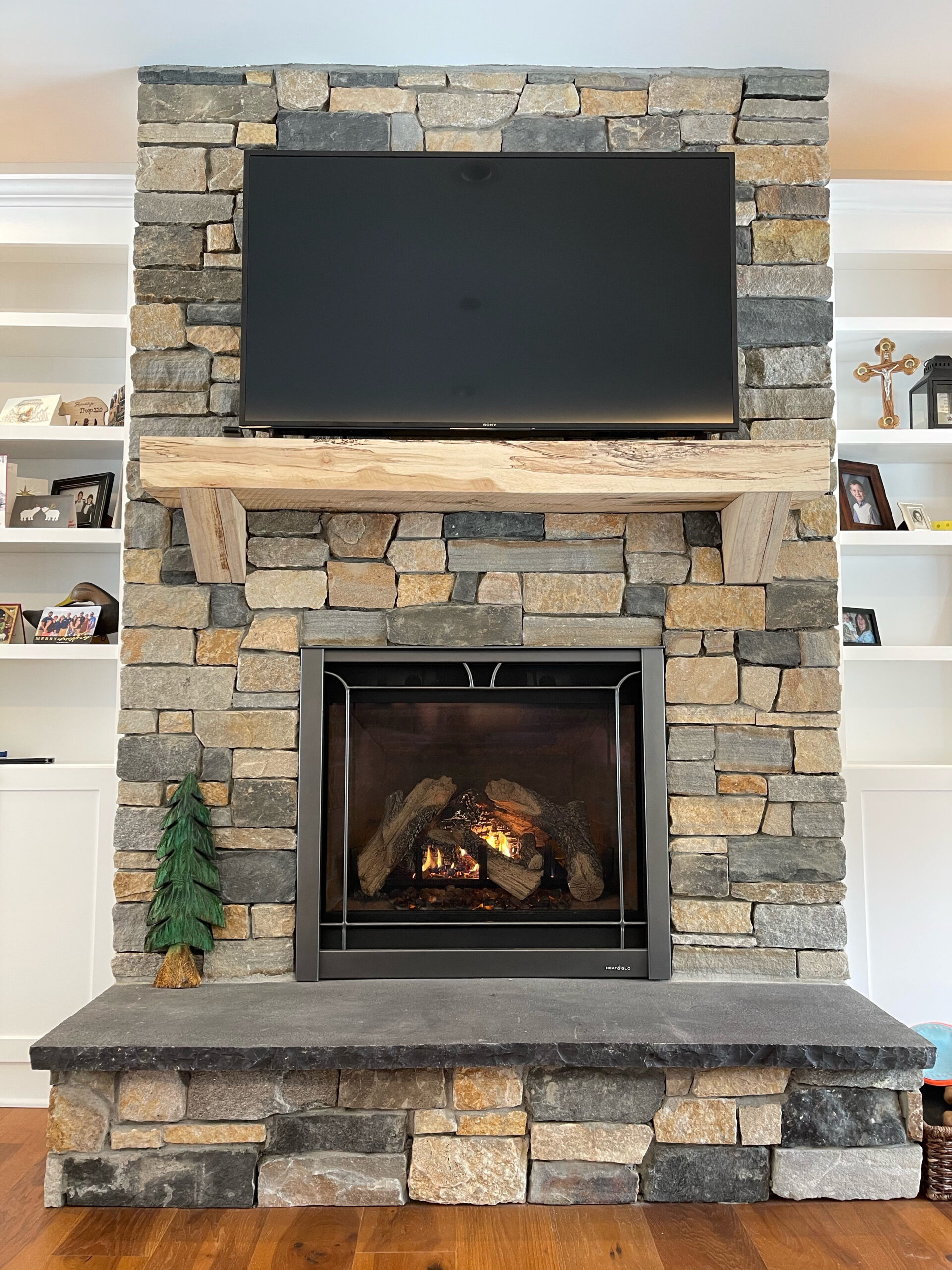
Combining Stone with Other Materials
Combining stone with other materials in your fireplace design can create a unique and personalized look that enhances the overall aesthetic of your home. The contrast and harmony between different materials can add depth, texture, and visual interest to the fireplace, making it a standout feature in the room. Here are some ideas for combining stone with other materials to create a stunning fireplace design.
Wood is a natural choice for pairing with stone, as it adds warmth and contrast to the design. A wooden mantel or surround can complement the rustic texture of the stone, creating a cozy and inviting look. The type of wood and finish can be selected to match the overall style of the room, whether it is a rich, dark wood for a traditional look or a light, unfinished wood for a more contemporary feel.
Metal is another material that pairs well with stone, offering a sleek and modern contrast. Stainless steel or wrought iron can be used for fireplace inserts, screens, and accents, adding a touch of industrial chic to the design. The cool, reflective surface of the metal can balance the natural, earthy texture of the stone, creating a harmonious and sophisticated look.
Glass can also be incorporated into stone fireplace designs to add a modern and elegant touch. Glass fireplace doors or panels can provide a clear view of the fire while enhancing the overall aesthetic. The transparency of glass allows the beauty of the stone to shine through, while also providing a functional barrier that improves safety and efficiency.
Tile is a versatile material that can be combined with stone to create intricate and colorful designs. Ceramic or porcelain tiles can be used to create decorative borders or patterns around the fireplace, adding a pop of color and texture. Mosaic tiles can also be used to create custom designs that reflect your style and taste.
Concrete is another material that can be paired with stone for a contemporary and industrial look. A concrete hearth or surround can provide a clean, minimalist contrast to the rough texture of the stone. The combination of these materials can create a modern, edgy design that stands out in any room.
Combining stone with other materials in your fireplace design can create a unique and personalized look that enhances the overall aesthetic of your home. Whether paired with wood, metal, glass, tile, or concrete, the contrast and harmony between different materials can add depth, texture, and visual interest to the fireplace. By exploring different combinations, you can create a stunning and functional fireplace that reflects your style and enhances your living space.

Adding Personal Touches
Adding personal touches to your stone fireplace can make it a true reflection of your style and personality. Customizing the design with unique elements and accessories can enhance the overall aesthetic and create a space that feels truly your own. Here are some ideas for adding personal touches to your stone fireplace.
One of the simplest ways to personalize your fireplace is by selecting decorative items that reflect your tastes and interests. Family photos, artwork, and souvenirs from travels can be displayed on the mantel or hearth to create a personalized and meaningful focal point. These items can be rotated seasonally or for special occasions, keeping the look fresh and interesting.
Incorporating custom-built elements into the fireplace design is another way to add a personal touch. A custom mantel, for example, can be designed to match your specific style and preferences. Whether you choose a rustic wooden beam, a sleek metal shelf, or a carved stone mantel, a custom-built piece can make your fireplace unique and special.
Personalized lighting can also enhance the look and feel of your fireplace. Custom-made sconces, pendant lights, or chandeliers can add a distinctive touch and complement the overall design. The choice of lighting fixtures, as well as the type and color of the light, can create different moods and atmospheres, making the space more inviting and comfortable.
Incorporating plants and greenery around the fireplace can add a touch of nature and life to the space. Potted plants, hanging planters, or a vertical garden can create a fresh and vibrant look. The choice of plants can reflect your taste and preferences, whether you prefer lush, tropical foliage or delicate, flowering plants.
Adding a personal touch can also involve integrating functional elements that cater to your lifestyle. Built-in shelves or storage units around the fireplace can provide space for books, games, or media equipment. A built-in bench or seating area can create a cozy nook for reading or relaxing by the fire. These functional additions can make the fireplace area more practical and enjoyable.
Adding personal touches to your stone fireplace can make it a true reflection of your style and personality. By incorporating decorative items, custom-built elements, personalized lighting, plants, and functional features, you can create a unique and inviting space that enhances the overall aesthetic of your home. These personal touches can make your fireplace a meaningful and cherished focal point in your living space.

Enhancing the Surrounding Space
Enhancing the space around your stone fireplace can create a cohesive and inviting look that elevates the overall aesthetic of your room. By carefully considering the design elements and decor in the surrounding area, you can create a harmonious and well-balanced space that complements the beauty of the fireplace. Here are some ideas for enhancing the space around your stone fireplace.
Furniture placement is an important aspect of creating a comfortable and functional space around the fireplace. Arrange seating to face the fireplace, creating a cozy and inviting gathering area. Consider using a combination of sofas, chairs, and ottomans to create a versatile and flexible seating arrangement. A coffee table or side tables can provide convenient surfaces for drinks, books, and decorative items.
Rugs and textiles can add warmth and texture to the space around the fireplace. A plush area rug can anchor the seating area and define the space, while throw blankets and pillows can add comfort and color. Choose textiles that complement the colors and textures of the stone fireplace to create a cohesive look.
Wall decor can enhance the visual impact of the fireplace and create a focal point in the room. Consider hanging artwork, mirrors, or decorative panels above or around the fireplace to add interest and personality. The choice of wall decor should reflect your style and complement the overall design of the room.
Lighting is another key element in enhancing the space around the fireplace. In addition to the integrated lighting in the fireplace itself, consider using floor lamps, table lamps, or wall sconces to provide ambient and task lighting. The placement and type of lighting can create different moods and atmospheres, making the space more versatile and inviting.
Plants and greenery can add a touch of nature and life to the space around the fireplace. Potted plants, hanging planters, or a vertical garden can create a fresh and vibrant look. The choice of plants can reflect your taste and preferences, whether you prefer lush, tropical foliage or delicate, flowering plants.
Enhancing the space around your stone fireplace involves careful consideration of furniture placement, rugs and textiles, wall decor, lighting, and plants. By thoughtfully incorporating these elements, you can create a cohesive and inviting space that complements the beauty of the fireplace and enhances the overall aesthetic of your room. A well-designed space around the fireplace can make it a true centerpiece in your home, providing warmth, comfort, and visual appeal.
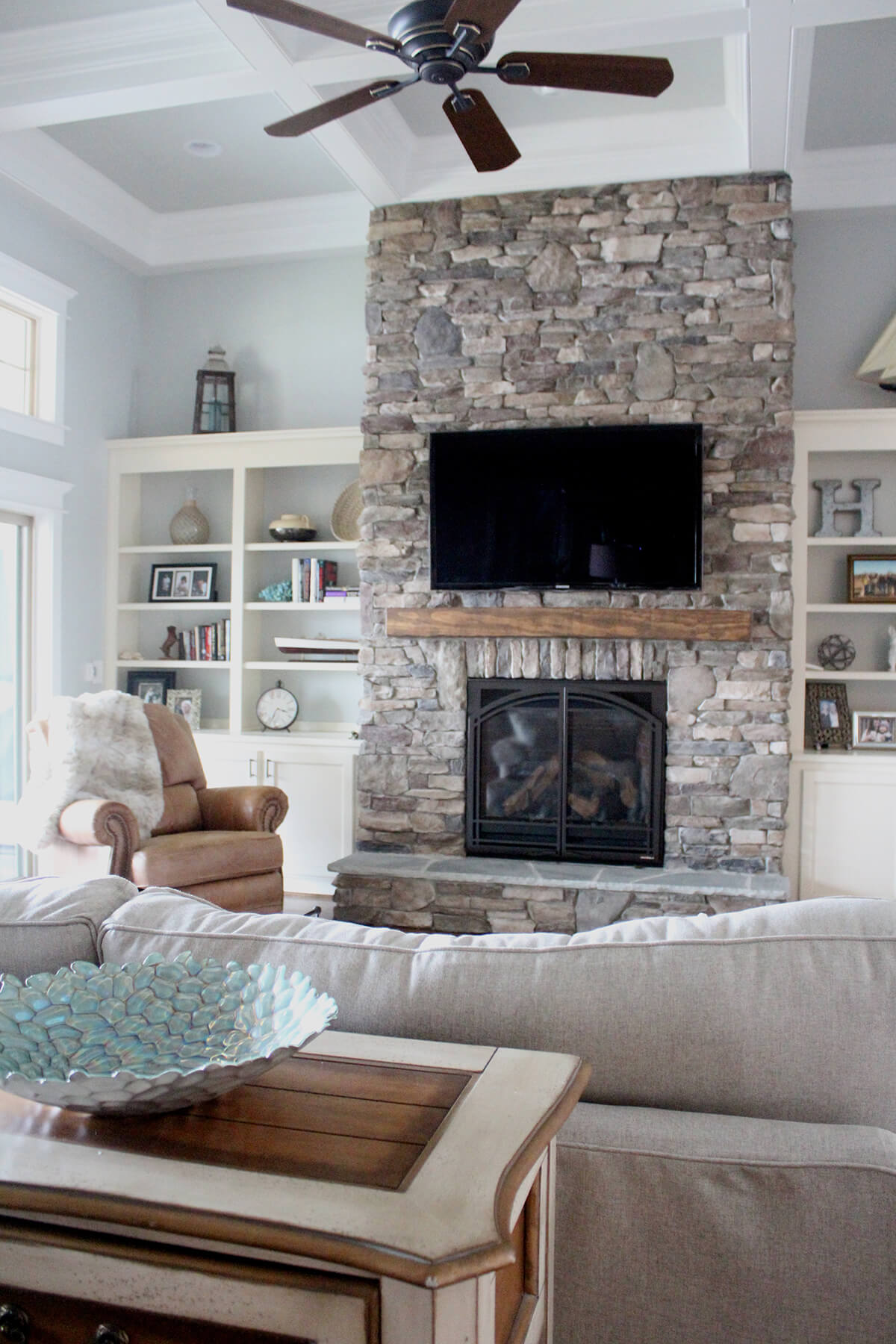
Related Posts: